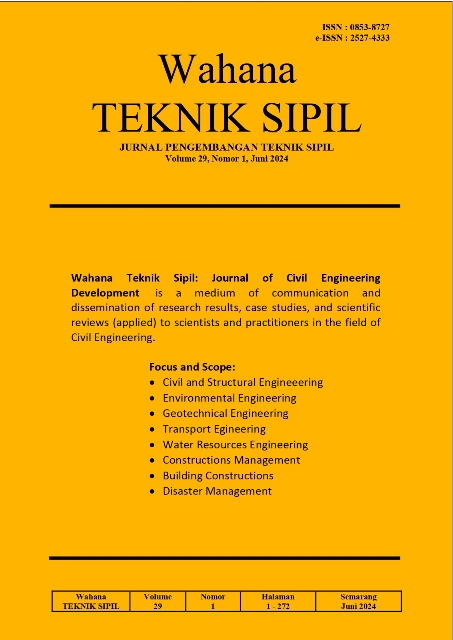REDUKSI NILAI AKTIF MATERIAL GUNUNG DENGAN STABILISASI PADA TIMBUNAN PILIHAN PERKERASAN PERBUTIRAN JALAN RAYA
DOI:
https://doi.org/10.32497/wahanats.v29i1.5655Keywords:
active, road, feasible, material, plasticity, stabilizationAbstract
The use of selected embankment materials in highway pavement work must meet the technical requirements in accordance with the applicable specifications. One source of mountain material exploited by the general public to meet the needs of residential construction and contractors on government projects is Golo Lalong Village, East Manggarai Regency, NTT Province. From previous research it is known that the mountain material from the quarry is not suitable for selected embankment work on roads because its active value is > 1.25 which is categorized as active material. This research was carried out with the aim of stabilizing the mountain material of Golo Lalong Village with mountain material from Kisol to reduce its active value. With 15% stabilization of Ex Kisol mountain material it is able to reduce the plastic limit value from 9 to 13 to 3 and the percentage passing the Number 200 sieve varies from 5.16% to 6.87%. The active value of the material resulting from the stabilization was reduced significantly from 1.25 to 2.43 become 0.44 to 0.97 so that the Golo Lalong Village mountain material with 15% stabilization of the Ex Kisol mountain material is suitable for use as an embankment option for highway granular pavement.
References
Adhi, B.W., 2022, Analisa Stabilitas Timbunan di Daerah Rawa Menggunakan Penanganan Limestone dengan Softwere Plaxis. Jurnal Media Komunikasi Dunia Ilmu Sipil (MoDuluS), 4 (1), 40”“45.
Alhakim, C.I., & Suhendra, A., 2019, Pengaruh Kenaikan Kuat Geser Tanah Terhadap Stabilitas Timbunan Di Atas Tanah Lempung Lunak Jenuh Air. Jurnal Mitra Teknik Sipil, 2 (4), 105”“112.
Dwina, D.O., Nazarudin, Kumalasari, D., & Fitriani, E., 2021, Stabilisasi Tanah Gambut Dengan Penambahan Material Kapur Dan Fly Ash Dari Sisa Pembakaran Cangkang Sawit Sebagai Subgrade Jalan. Fondasi, 10 (1), 24”“32.
Dzakky, F., 2021, Public Private Partnership: Alternatif Pembangunan Infrastruktur dalam Negri. SALAM: Jurnal Sosial Dan Budaya Syar-I, 8 (2), 573”“584.
Gazali, A., & Farhurrahman, 2019, Analisis Stabilitas Tanah Timbunan Dengan Perkuatan Turap Kayu Galam Di Daerah Rawa Kalimantan Selatan. Media Ilmiah Teknik Sipil, 7 (1), 79”“86.
Gon, K., Cornelis, R., & Rustendi, I., 2022, Kelayakan Material Desa Golo Lalong Sebagai Bahan Timbunan Pilihan Pekerjaan Jalan Berdasarkan Nilai Aktif Material. Teodolita: Media Komunkasi Ilmiah Di Bidang Teknik, 24 (1), 84”“100.
Hadisaputra, A., Aswar, Arifin, W., Maruddin, M., & Arief, M., 2019, Analisis Penggunaan Pasir Terhadap Stabilisasi Tanah pada Wilayah Danau Tempe Untuk Dijadikan Sebagai Material Timbunan. JILMATEKS, 1 (2), 226”“235.
Hartono, J., Khoiroh, U., & Saleh, M., 2022, Stabilitas Tanah Timbunan Sisi BH-1 Proyek Jalan Akses Pembangunan Jembatan Pulau Balang II. BENTANG: Jurnal Teoritis Dan Terapan Bidang Rekayasa Sipil, 10 (1), 1”“10.
Kementerian Dalam Negeri, 2016, Peraturan Menteri Dalam Negeri Nomor 1 Tahun 2016 tentang Pengelolaan Aset Desa.
Khatab, U., Asnur, H., & Yunita, R., 2022, Klasifikasi Tanah Di Lima Kecamatan Kota Payakumbuh Dengan Sistem Aashto. REKAYASA, 12 (02), 164”“174.
Kusdiyono, Supriyadi, Mulyono, T., & Sukyono, 2019, Pengaruh Penambahan Limbah Plastik Jenis Thermosetting Terhadap Parameter Marshall Laston AC-WC. Wahana Teknik Sipil: Jurnal Pengembangan Teknik Sipil, 24 (2), 166”“179.
Ludfian, M., & Wibowo, D.E., 2017, Stabilisasi Tanah Lempung Menggunakan Campuran Limbah Abu Sekam Padi Dan Pasir Dengan Metode Pemadatan Laboratorium. Inersia: Jurnal Teknik Sipil Dan Arsitektur, 13 (1), 66”“75.
Martina, N., Hasan, F.M.R., & Setiawan, Y., 2019, Pengaruh Serbuk Ban Bekas Sebagai Campuran Agregat Halus Pada Campuran Aspal Porous. Wahana Teknik Sipil: Jurnal Pengembangan Teknik Sipil, 24 (2), 144”“152.
Prakoso, A., Mukhlisin, M., Rahardjo, P., & Junaidi, 2019, Analisis penurunan timbunan tanah silt pada proyek jalan ruas giriwoyo-duwet wonogiri. Wahana TEKNIK SIPIL, 24 (2), 153”“165.
Prayitno, S., Wibowo, W., & Widiatmoko, W., 2014, Pengaruh Abu Sekam Padi Sebagai Pengganti Sebagian Semen Dan Variasi Serat Bendrat Pada Beton Mutu Tinggi Terhadap Kuat Tekan, Permeabilitas Dan Penetrasi Beton. E-Jurnal MATRIKS TEKNIK SIPIL, 4 (4), 960”“967.
Saputra, N.A., & Respati, R., 2018, Stabilisasi Tanah Gambut Palangkaraya dengan bahan campuran tanah non organik dan kapur. Media Ilmiah Teknik Sipil, 6 (2), 124”“131.
Sari, F., & Istiatun, 2022, Analisis Stabilitas Timbunan Dengan Perkuatan Geotekstil Dan Cerucuk. Construction and Material Journal, 4 (3), 1”“15.
Srihandayani, S., Abrar, A., & Indrawan, S., 2019, Stabilisasi Berbasis Ion Exchange Untuk Meningkatkan Daya Dukung Subgrade Di Kota Dumai. Siklus : Jurnal Teknik Sipil, 5 (2), 63”“69.
Syahril, S., Suyono, A., Prajudi, R., & Riandi, R., 2022, Perbaikan Tanah Problematik Lempung Lunak Dengan Metode Stabilisasi Kimiawi Ditinjau Dari Nilai Kadar Air Dan Indeks Plastisitas. Wahana Teknik Sipil: Jurnal Pengembangan Teknik Sipil, 27 (2), 244”“251.
Tecnikal, D., Surjandari, N.S., & Dananjaya, H., 2016, Stabilisasi Tanah Gambut Menggunakan Campuran Serbuk Bata Merah Ditinjau Dari Pengujian CBR. E-Jurnal : MATRIKS TEKNIK SIPIL, 4 (3), 960”“967.
Downloads
Published
Issue
Section
License
Authors who publish with this journal agree to the following terms:Authors retain copyright and grant the journal right of first publication with the work simultaneously licensed under a Creative Commons Attribution License that allows others to share the work with an acknowledgement of the work's authorship and initial publication in this journal.
Authors are able to enter into separate, additional contractual arrangements for the non-exclusive distribution of the journal's published version of the work (e.g., post it to an institutional repository or publish it in a book), with an acknowledgement of its initial publication in this journal.
Authors are permitted and encouraged to post their work online (e.g., in institutional repositories or on their website) prior to and during the submission process, as it can lead to productive exchanges, as well as earlier and greater citation of published work (See The Effect of Open Access).






